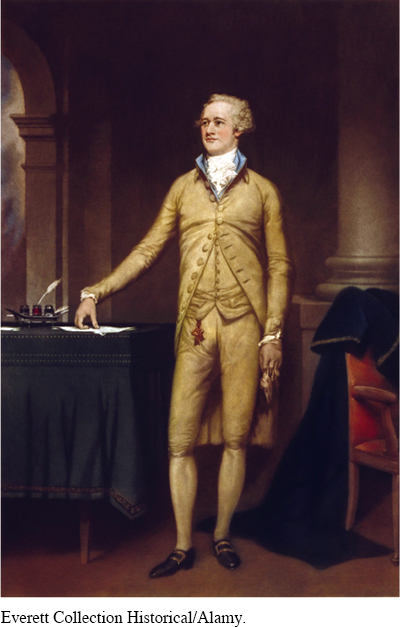Introduction to Chapter 9
225
9
The New Nation Takes Form
1789–

CONTENT LEARNING OBJECTIVES
After reading and studying this chapter, you should be able to:
Identify the sources of stability and change in the 1790s.
Explain Alexander Hamilton’s three-
part economic program, including the parts that were adopted and those that failed, and why the program was controversial. Understand how foreign and domestic conflict, including fighting in the Ohio Valley, the Haitian Revolution, and the wars between England and France, influenced the early Republic.
Understand how the Federalist and Republican parties developed, and in what ways the 1796 election, the XYZ affair, and the Alien and Sedition Acts polarized the two.
ALEXANDER HAMILTON, THE MAN WHO BRILLIANTLY UNIFIED the pro-
Hamilton grew up on a small West Indies island, the son of an unmarried mother who died when he was eleven. He developed a fierce ambition to overcome his disadvantages and make good. After serving an apprenticeship to a trader, the bright lad made his way to New York City, where he soon gained entry to college. During the American Revolution, he wrote political articles for a newspaper that caught the eye of General George Washington, who was moved to select the nineteen-
A Cinderella story characterized Hamilton’s private life, too. Handsome and now well connected, he married a wealthy merchant’s daughter. He had a magnetic charm that attracted both men and women; at social gatherings, he excelled. Late-
As secretary of the treasury, Hamilton took quick action to build the economy. “If a Government appears to be confident of its own powers, it is the surest way to inspire the same confidence in others,” he remarked. He immediately tackled the country’s unpaid Revolutionary War debt, producing a complex proposal to fund the debt and pump millions of dollars into the U.S. economy. He drew up a plan for a national banking system to manage the money supply. And he designed a system of government subsidies and tariff policies to promote the development of manufacturing interests.
226

Hamilton was both visionary and practical, a gifted man with remarkable political intuitions. Yet this magnetic man made enemies; the “founding fathers” of the 1770s and 1780s became competitors and even bitter rivals in the 1790s. Both political philosophy and personality clashes created friction.
Hamilton’s charm no longer worked with James Madison, now a representative in Congress and an opponent of all of Hamilton’s economic plans. His charm had never worked with John Adams, the new vice president, who privately called him “the bastard brat of a Scotch pedlar” motivated by “disappointed Ambition and unbridled malice and revenge.” Years later, when asked why he had deserted Hamilton, Madison coolly replied, “Colonel Hamilton deserted me.” Hamilton assumed that government was safest when in the hands of “the rich, the wise, and the good”—by which he meant America’s commercial elite. By contrast, agrarian values ran deep with Jefferson and Madison, and they were suspicious of get-
The personal and political antagonisms of this first generation of American leaders left their mark on the young country. Leaders generally agreed on Indian policy in the new Republic—
By 1800, the oppositional politics ripening between Hamiltonian and Jeffersonian politicians would begin to crystallize into political parties, the Federalists and the Republicans. To the citizens of that day, this was an unhappy development.
CHRONOLOGY
| 1789 |
|
| 1790 |
|
| 1791 |
|
| 1793 |
|
| 1794 |
|
| 1795 |
|
| 1796 |
|
| 1797 |
|
| 1798 |
|
| 1800 |
|